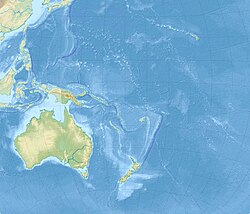| UNESCO World Heritage Site | |
|---|---|
 The Bonin Islands or the Ogasawara Islands comprises three main island groups—Chichijima, Hahajima, and Mukojima—located SSE of Tokyo. Administratively, they also include the nearby Volcano Islands (including Iwo Jima). | |
| Official name | Ogasawara Islands |
| Location | Japan |
| Includes | Islands, reefs, and marine areas |
| Criteria | Natural: (ix) |
| Reference | 1362 |
| Inscription | 2011 (35th Session) |
| Area | 7,939 ha (30.65 sq mi) |
| Coordinates | 27°43′6″N 142°5′59″E / 27.71833°N 142.09972°E |
The Bonin Islands, also known as the Ogasawara Islands (pronounced: [ogasawaɾa]) (小笠原諸島), is a Japanese archipelago of over 30 subtropical and tropical islands located around 1,000 kilometers (620 mi) SSE of Tokyo and 1,600 kilometers (1,000 mi) northwest of Guam.[1][2] The group as a whole has a total area of 84 square kilometers (32 sq mi) but only two of the islands are permanently inhabited, Chichijima and Hahajima. Together, their population was 2,560 as of 2021. Administratively, Tokyo's Ogasawara Subprefecture also includes the settlements on the Volcano Islands and the Self-Defense Force post on Iwo Jima. The seat of government is Chichijima.
Because of the Bonins' isolation, many of their animals and plants have undergone unique evolutionary processes. It has been called "the Galápagos of the Orient" and was named a natural World Heritage Site in 2011. When first reached during the early modern period, the islands were entirely uninhabited. Subsequent research has found evidence of some prehistoric habitation by Micronesians. Upon their repeated rediscoveries, the islands were largely ignored by the Spanish, Dutch, and isolationist Japanese until finally being claimed by a passing British captain in 1827. American, European, and Hawaiian colonists arrived from the Kingdom of Hawaii in 1830. Subsequently, Meiji Japan successfully colonized and reclaimed the islands in 1875, but the original multicultural community continued up to World War II, when most islanders were forcibly relocated to Honshu. Following Japan's defeat, the U.S. Navy occupied the island, bulldozing existing Japanese homes and restricting resettlement until full control of the Bonins was returned to Japan in 1968. Ethnically, the island is now majority Japanese but remains unusually diverse, which is reflected in the local Creole language known as Bonin English. Improved transportation has made agriculture more profitable and encouraged tourism, but the development required for an airport remains a contentious local issue.
